2023 Digital Art Trends: Insights by Metageist
2023 Digital Art Trends: Insights by Metageist
As we look back at 2023, the landscape of digital art continues to evolve at an unprecedented pace. Driven by technological advancements and cultural shifts, this year is marked by transformative ideas that challenge our perceptions of creativity, ownership, and experience. The fusion of Web3, artificial intelligence, and immersive technology heralds a new era in the art world—one that invites participation, experimentation, and collective growth.
The Rise of Web3 and Decentralized Ownership
At the heart of today’s digital renaissance lies the promise of Web3. This decentralized web framework democratizes access to creative tools and platforms, empowering artists and collectors alike. The launch of innovative platforms such as Foundation, SuperRare, and ArtBlocks exemplifies this shift, allowing creators to mint, sell, and trade their artworks directly on the blockchain. NFTs (Non-Fungible Tokens) have emerged as the medium through which digital art can possess intrinsic value and scarcity, shifting the traditional art market paradigm.
Blockchain technology not only verifies ownership but also ensures artists receive royalties from secondary sales. This newfound dynamic is empowering underrepresented voices, fostering a vibrant ecosystem where emerging creators can thrive. The rise of Decentralized Autonomous Organizations (DAOs) such as The Museum of Crypto Art emphasizes community-driven curation and collective ownership, redefining how art can be appreciated and supported.
AI-Driven Creativity: Redefining the Artist’s Role
The integration of artificial intelligence into artistic workflows is transforming what it means to be a creator. Tools like Runway and DALL-E empower artists to experiment with generative art and interactive pieces that push conventional boundaries. AI is not merely a tool but a collaborator, generating ideas and creative prompts that may not have emerged in traditional settings.
Emerging projects like DeepDream harness neural networks to reimagine existing images into hallucinogenic visuals, blurring the line between human creativity and machine learning. This technology enables artists to explore complex themes while provoking discourse on authorship and originality in the digital domain.
Immersive Technology: The Metaverse and Beyond
The metaverse presents a compelling frontier for digital art, where virtual and augmented realities (VR/AR) create immersive experiences that captivate audiences. Platforms such as Somnium Space and Spatial enable users to engage with art in dynamic environments. Imagine strolling through a gallery where the walls are alive with swirling animations and interactive installations that respond to your movements—a reality that is not far off.
Artists are quickly adapting to this landscape, crafting works that require active participation. Projects like cryptovoxels allow users to build and curate their own spaces, turning the act of viewing art into an experience of co-creation. This transformation invites spectators to step beyond the traditional observer role, fostering deeper connections with the art.
The Intersection of Art, Technology, and Culture
As digital spaces expand, the cultural implications are profound. Artists, technologists, and developers are converging to explore collaborative narratives through interactive storytelling. Platforms like Twine offer creators the ability to craft nonlinear stories that merge visual art with gameplay, enriching the narrative experience.
In embodying change, we see a growing trend of using art for social commentary, addressing pressing global issues such as climate change, mental health, and social justice. Innovative projects like Refugee Art Project leverage technology to amplify underrepresented voices, creating spaces for dialogue and action.
A Vision for the Future
Looking ahead, the integration of immersive technology, AI, and Web3 is likely to achieve further sophistication. As the capability for digital artistry expands, we may witness the emergence of entirely new genres that seamlessly blend art with interactive experiences. Virtual galleries might become commonplace, filled with multifaceted installations that invite visitors to become part of the artistic narrative.
The impact of advancements will not be limited to aesthetics; they’ll challenge our definitions of authorship and ownership, raising questions about creativity’s nature in a world where machines can generate works of art. Moreover, as the barriers between virtual and real continue to dissolve, the cultural significance of digital art will only grow.
As we embrace this dynamic landscape, our role as creators, curators, and consumers becomes more vital. We are called to engage critically with these technologies, exploring their implications while actively participating in shaping a future where art transcends traditional confines.
In this brave new world, digital experiences await your exploration, experimentation, and engagement. Each breakthrough invites us to redefine what art can be—so step boldly into the future and discover the infinite possibilities that lie ahead.
This glimpse into the digital art trends of 2024 hints at just the beginning of a revolution that promises to reshape our understanding of creativity, engagement, and ownership. As you navigate this landscape, consider how you might contribute to the dialogue and cultivate your artistic journey in the process.
Share this post.
Whispers of the Cursed Codex
Whispers of the Cursed Codex The flickering glow of the monitor cast an eerie pallor across the darkened laboratory, illuminating the jittery figure of Jonathan Muir as he leaned closer, breath caught in his throat. [...]
Null’s Revolt: Hacking the Heart of Meta-Cities
Null's Revolt: Hacking the Heart of Meta-Cities In the cybernetic streets of Astral Nexus, a sprawling meta-city split between concrete towers and endless digital fog, whispers of a rebellion coursed through every virtual alley. Null, [...]
Exploring NFT Installations: A Metageist Insight
Exploring NFT Installations: A Metageist Insight As we stand on the precipice of a new digital frontier, the fusion of art, technology, and culture continues to redefine our understanding of ownership and creativity. The rise [...]

